National Grid’s Renewable Energy Growth program contracted with the Cadmus Group to inspect 100 solar power systems installed in the state. The powerpoint version of the report, Study of Renewable Energy Installation Quality in Rhode Island (the official presentation can be found here – pdf), looked at 100 installations in the state in November of 2018. The group found that 45% of the 86 residential, 8 medium sized and 6 large sized projects – built by 27 companies – inspected exhibited major or critical installation deficiencies.
The program’s scoring metric is as follows:
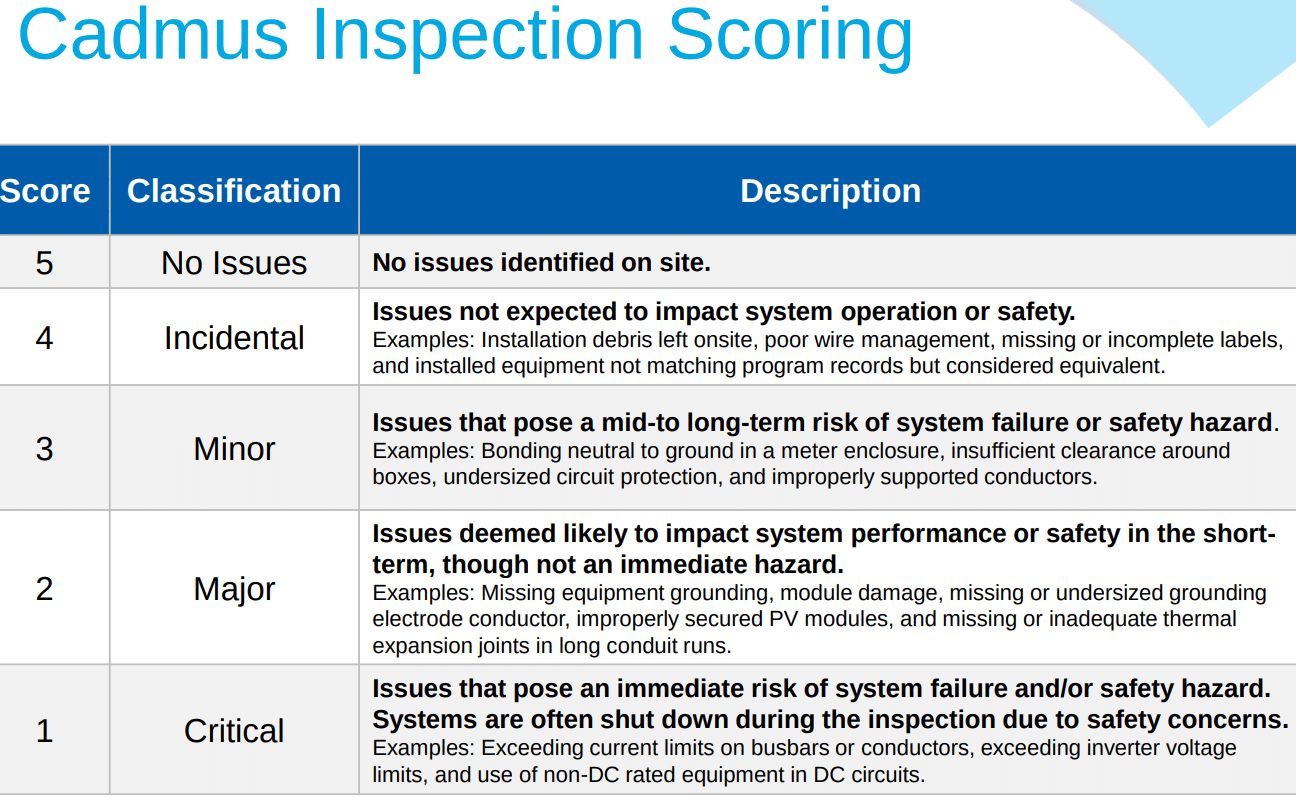
Looking at the residential projects, the issues by inspection element were:
- AC Combiner – 31
- AC Disconnect – 5
- Array – 190
- Inverter – 81
- Junction Box- 6
- Optimizer – 4
- Overall Observations – 3
- Production Meter – 2
- Supply-Side Connection – 187
- Total – 509
Cadmus noted that more than 70% of installation companies responded to reports of their system installation issues, however, only 33% of those reports resulted in actual corrective actions.
In the small-scale systems, there were 25 examples of racking mechanical connection issues, such as connections incorrectly made or variations from the installation instructions. The below image shows a missing rail support, that could lead to premature system failure as the aluminum could bend over time, shifting the solar modules connection to the racking system.
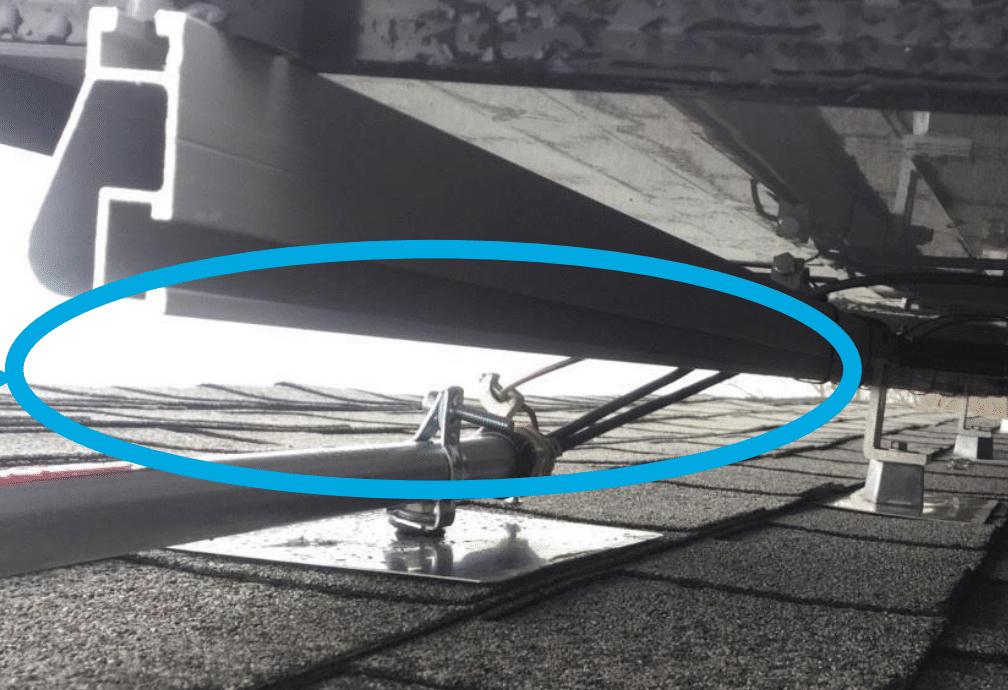
Improperly secured solar modules were noted in 28 instances in small scale installations, with missing, incompatible, or inappropriately-installed hardware. Missing clamps, bent bolts (see header image) due to incorrect cuts to the length of rails, and incorrect hardware used in tying down modules. While most of these issues weren’t considered critical – over the long time – they can lead to hardware not staying in place.
Conductor – wiring – issues were also observed, and comprised most issues noted with medium and large scale system. For instance, below a rooftop solar installation’s rapid shutdown requirements aren’t properly met as the hardware to manage this shutdown process was located more than ten feet from the solar modules to be shut down in the event of an incident.
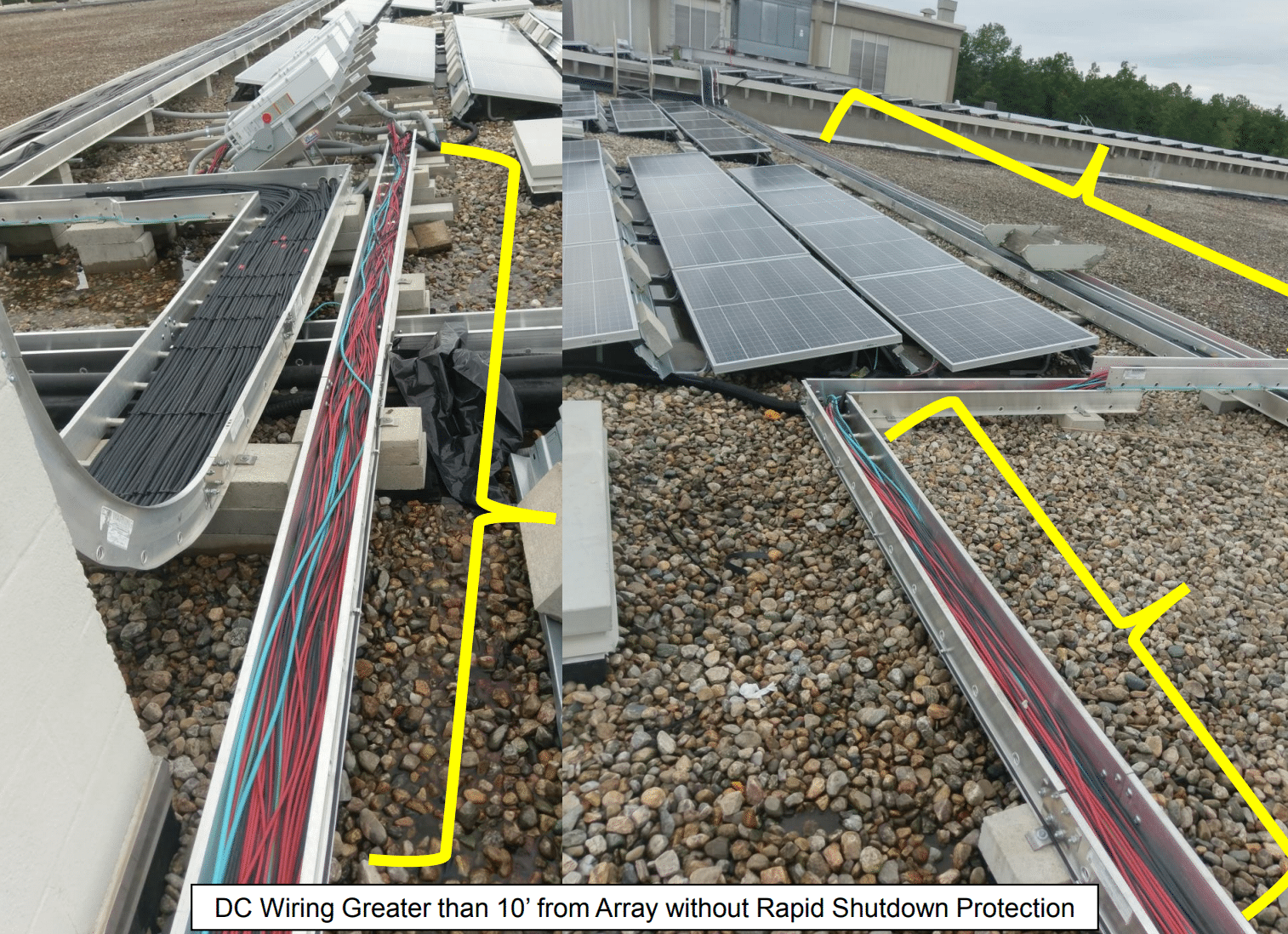
Other conductor issues included, unprotected or improperly-supported conductors. These issues lead to wires lain atop metals (below image)that can cut through the outer sheath over time, or unsupported wires that can sit in water if it pools on the roof.
Two instances of DC connectors not properly connected or used outside of the product listing were found (and this is actually one of the main issues that were found in the Tesla-Walmart fires). Cadmus notes that hazards exist when DC connectors are not properly installed, these connections can cause heat, arcing, poor electricity generation efficiency or a thermal event (fire).
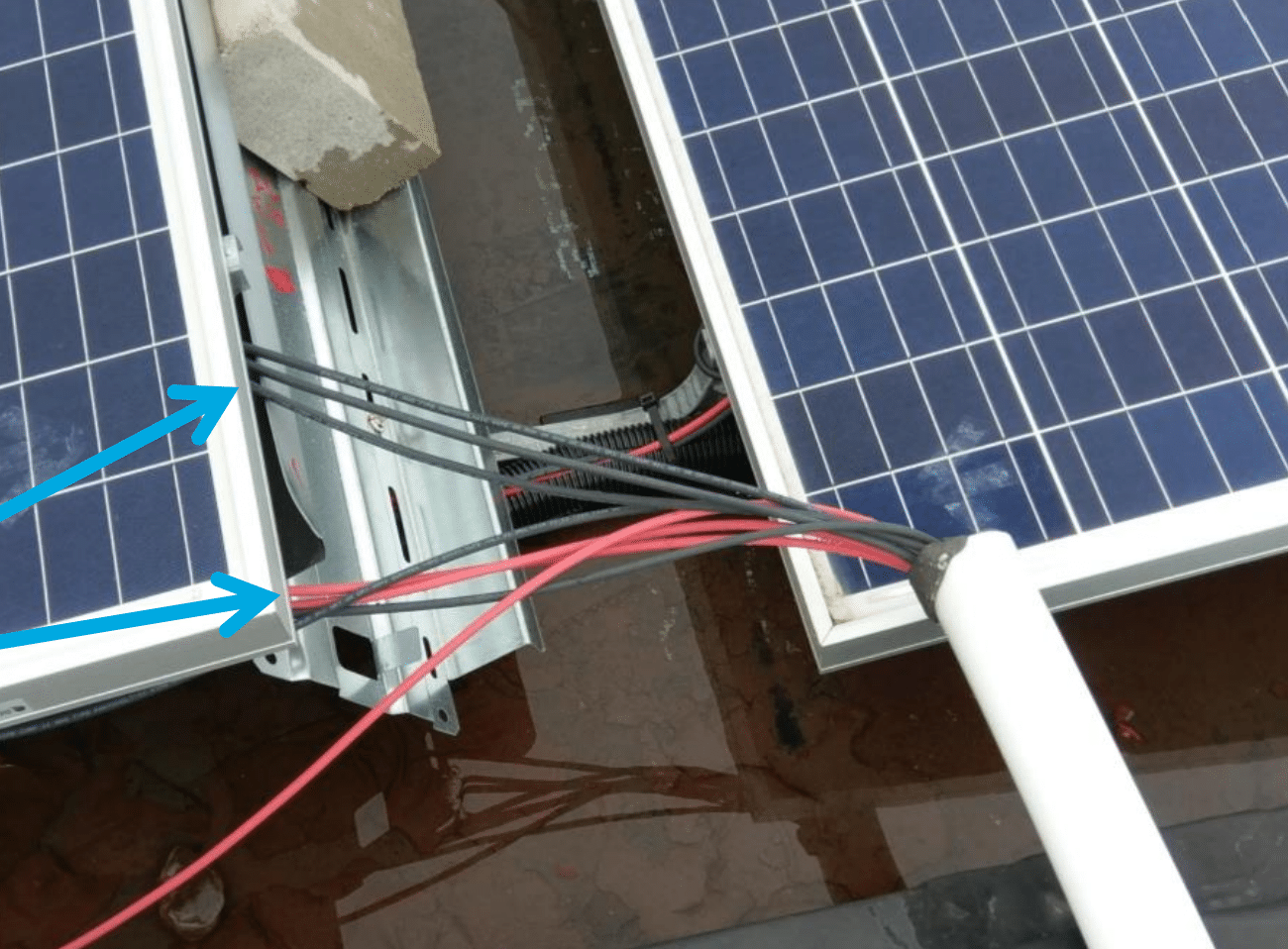
Rhode Island also inspected the interconnection techniques – and Cadmus actually found that there were four systems installed (3 residential and one commercial installation) – in which the solar power system wasn’t actually hooked up to an electrical meter that was measuring the production. Obviously an issues.
There were also 23 noted wire splice issues, such as methods not rated for the specific environment or conductor type, which over time would lead to risk of premature failure due to environmental conditions. For example, the below connectors not suitable for exposed outdoor locations.
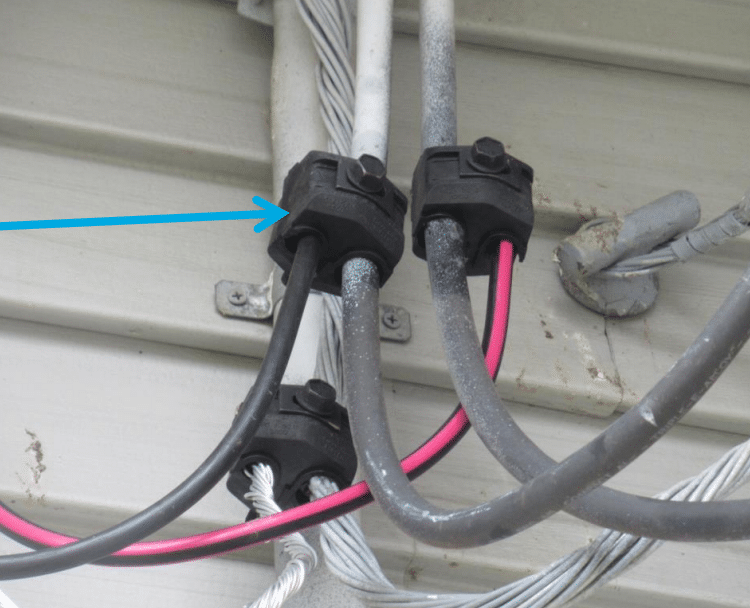
In general though, most customers – 86% – were still very happy with their installations, with 12% having a negative perception of things. And even though most customers were happy, 26% of respondents said payments generated by their system were lower than expected. Some of them were not properly informed of the tax implications of cash payments generated by the system, that monthly payments are dependent on actual energy produced, and weren’t fully communicated the delays between when the system started producing energy and when credits appeared on the utility bill.
Editor’s note: Are you interested in learning more about solar installation techniques, and how to avoid fires at solar plants? Be sure to attend pv magazine’s Quality Roundtable at the Solar Power International trade show in Salt Lake City on September 25, from 2 PM to 4:30 PM. Space will be limited, so click here to learn more and to register.
This content is protected by copyright and may not be reused. If you want to cooperate with us and would like to reuse some of our content, please contact: editors@pv-magazine.com.
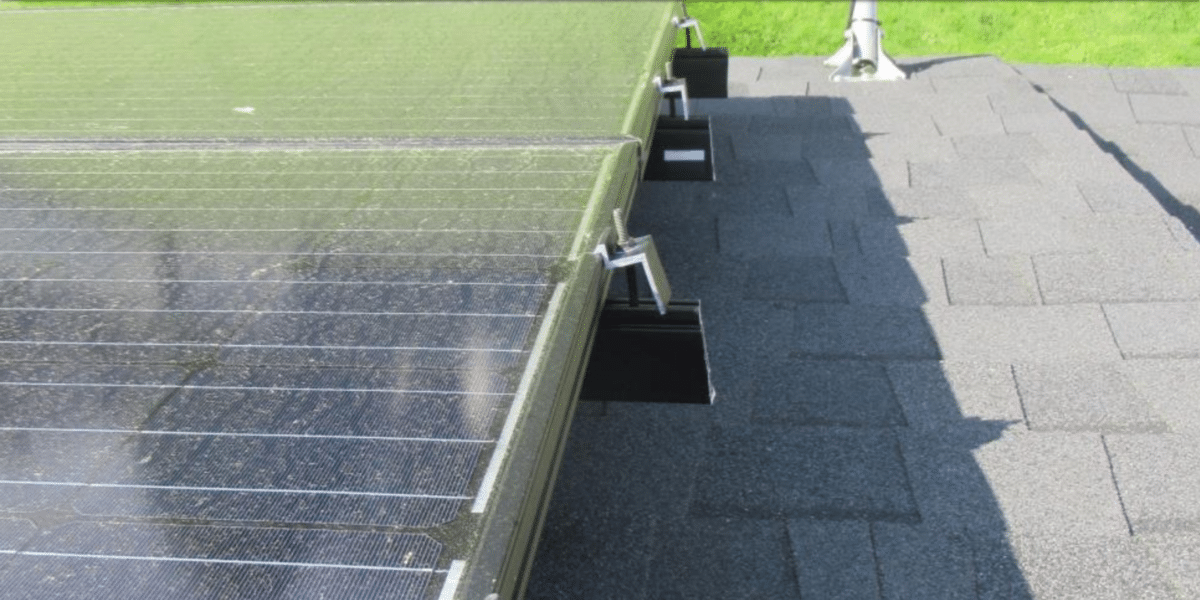
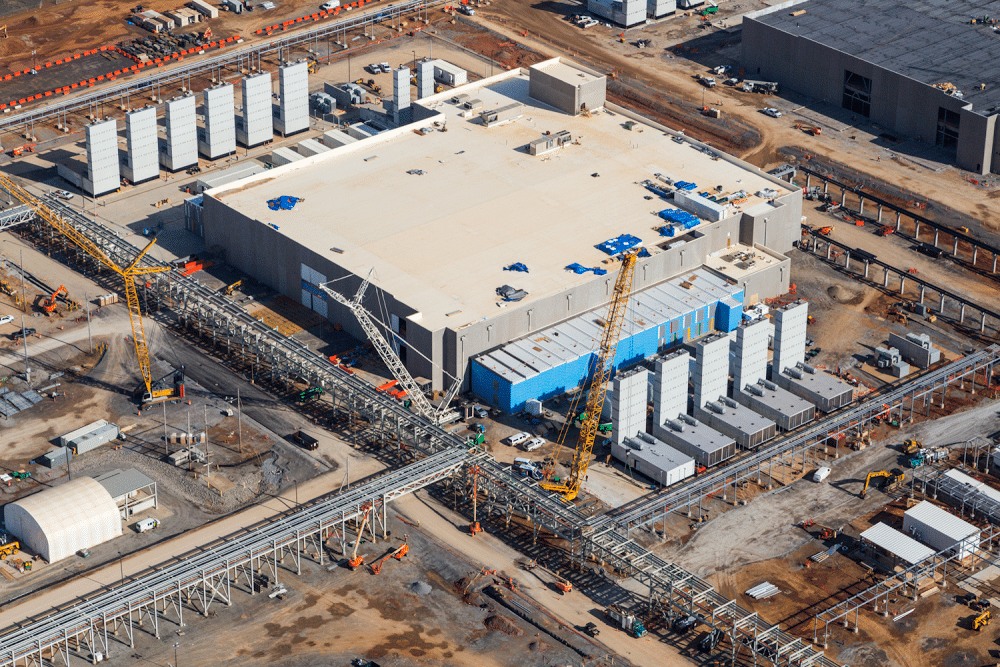






Really excellent article. Thanks for all of this insight into hazards during installation. Invaluable to the installer and customer. An article like this changes the game in safety and minimizing liability. Would love to see some writing on the Tesla incidents.
The article tells me the customer, whether commercial or residential, never bothered with their own inspections. I have put solar on 2 homes and did 85%+ of the installation myself. I did this as the installers wanted more to install than I was paying for the equipment. If you have ever put together a toy such as an Erector set then you can do much of the install. The inspector told me that I had actually done a better and more thorough job than he usually saw. All I did was read the instructions and followed them if I had a question I called the equipment supplier. It has been 15 years since my first job and those years have passed without any issues.
I was prepared for this, but it turns out that Federal solar credits are contingent upon installation by a certified solar installer, regardless of city or state inspections. Did you become certified, or was this not required in your case?
While all solar hardware is made to be electrical and mechanical code compliant, the weakest link in solar installations is the crew on the rooftop and their managers. Carelessness can kill. Such lack of professional due diligence is unconscionable. Homeowners pay the price.
Perhaps a rating for installers based on mandatory public professional reviews of installations would help in saving homeowners from solar installation dangers while keeping installers on the straight and narrow path.
Many new grid tied PV system owners think the system is under producing because of how their energy is calculated on their bill. There are three parts to consider when analyzing your bill.
1.) The energy you produce that’s running your house isn’t credited unless your producing in excess of what is needed. The excess production is what’s showing as a credit.
2.)If your producing only what is required then your bill doesn’t show a credit.
3.)The amount you’re being bill that the utility has provided is reduced by the amount you have produced.
Most systems are underproducing as compared to the estimated power production because most solar sales experiences are based upon ideal conditions 100% of the time. I went through 16 solar “estimates” which were pie in the sky, and in some cases broke the laws of physics, before finding a company which listened to my concerns, gave me a realistic estimate (1/3 lower than everyone else), and I have been meeting that estimate for three years. If I had believed the first 16 people, I would be very, very upset, and feel that I was scammed. Now, I am very satisfied.
This report is in line with what we find. We service residential and commercial. We perform solar maintenance and repair on systems from San Diego to Sacramento California. We find that most residential jobs we inspect have something wrong with them. Most issues we see are in junction boxes and raceways/conduits.
Good, useful article.
In the first photo, I doubt that there is an issue with the rail support as the article states. Due to the camera angle, there is not an easy way to measure the overhang of what looks to be XR-100 rail, but it looks compliant because the ends of XR-100 are allowed to have significant overhang from the last mount (potentially in excess of 30 inches). I suspect what is actually the issue in the photo (and is circled) is that the wiring enters the conduit without the benefit of a junction box. We also can’t really tell if the cable entrance is weather tight.
In general, I think people are disappointed in their output just based on talking to friends about their new solar installations. I generally estimate about 30% loss, so that the expectations are managed. Sadly, homeowners cannot rely on inspections because the amount of details to be inspected exceeds the time that inspectors have. IMO, if the inspector sees quality techniques used in construction of the system, the inspection is brief so that more time can be allocated to bad installations.
As a licensed electrician in Ma. & R . I. With 40 plus years in all areas of the trade and Involved in residential & small to mid- size commercial solar installations for past 8 years I find and hear that many companies that sell & or install are done by unqualified people.
I would put it at 80 to 90 % of companies installation crews are sent out without a license electrician on site. The lack of knowledge, That goes from office personnel to the person putting the B.O.M. together for crews is an embarrassment to our trade. I find the majority of the A. H. J. are lacking knowledge on solar . The lack of time they spend on site looking over a project is sad . From undersized wire on feeders, improper fittings to terminations. The neat & Workman like manner , voltage drop calculation , an most important I feel the 125% continuous load wire sizing on the AC and DC wires is a past tense in solar installations.
Many hands on tradesmen will not take a solar job for them reasons. Most rather avoid going to work for a solar company where they maybe the only journeyman in a shop of 6 plus installers.
There seems to be so much money involved in solar for companies , that the most unorganized companies make money .
When roofers and general labor help start calling them selfs Solar Technicians and have no electrical experience , no understanding of grounding / bonding , wire management, systems fail and fires happen.
Starting couple years ago the rate of service calls for bad connections, poor workmanship ( piping falling off roofs & sides of buildings) is gone up and only gonna climb
The Solar part of the electrical field is just about the only part that most lenders ( from what I hear based on grants ,) require a Cadmus/3 rd party inspection . There inspection over rides A. H .J. , so what’s that say about solar and local inspectors ? When someone with little electrical back ground , watches couple videos , has a day or so class , that has a list & photos of how a job should be installed can fail a job after a local inspection has passed, again what’s that say about the solar electrical industry .